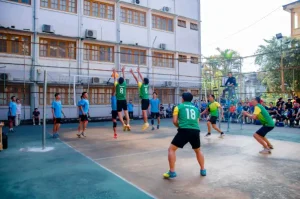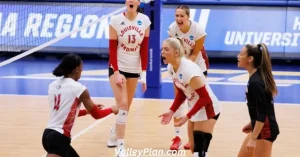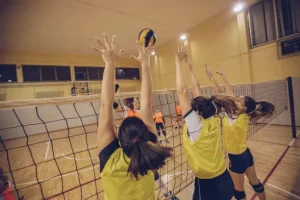The “back row attack” also known as “back attack” in volleyball requires talent, preparation, and collaboration. So, what exactly is a back row attack? It’s when a player in the back row advances to the net to strike the ball.
However, there’s a catch – the takeoff must be from behind the ten-foot line. This adds an extra layer of challenge, demanding precise timing and coordination from the player.
This guide will help players and viewers understand how this move works, how to use it, and how it alters the game.
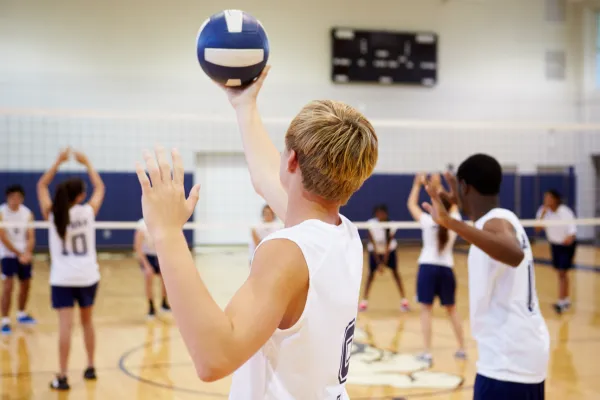
Volleyball Basics and Player Positions
Start with the essentials. Each volleyball player has one of six roles. Three players make up the first and rear rows. Understanding these regions is crucial before discussing the back row attack.
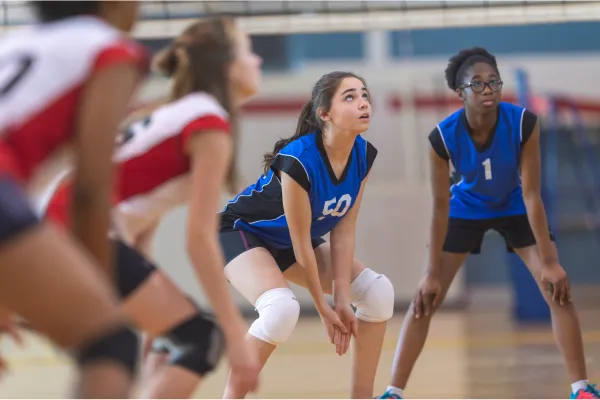
Mechanics of back row attack
Executing a successful back row attack involves nailing down some basic mechanics. Speed, quickness, and form are crucial around the net. Additionally, timing is vital, and proper body placement and foot movement are essential for power and precision.

Back Row Attack Rules for Volleyball
Back row attack regulations in volleyball are unique to ensure fair play and game integrity. The main rules are:
| Sr No | Rule | Description |
|---|---|---|
| 1 | Player Position | Only back row players, typically in positions 1, 5, and 6, are allowed to perform back row attacks. |
| 2 | Takeoff Point | The takeoff for a back row attack must be from behind the ten-foot line. |
| 3 | Ball Contact | The player executing the back row attack must contact the ball while it is still entirely above the net. |
| 4 | Foot Faults | Back row players must avoid committing foot faults, ensuring both feet remain in contact with or directly above the floor until the ball is contacted. |
| 5 | Libero Limitations | The libero is not allowed to perform back row attacks, as their role is primarily defensive. |
| 6 | Rotational Order | Players must adhere to the rotational order when transitioning from back to front row, and only front row players are permitted to jump and attack above the net. |
| 7 | Referee Decisions | Referees closely monitor back row attacks, penalizing violations with a point awarded to the opposing team and the right to serve. |
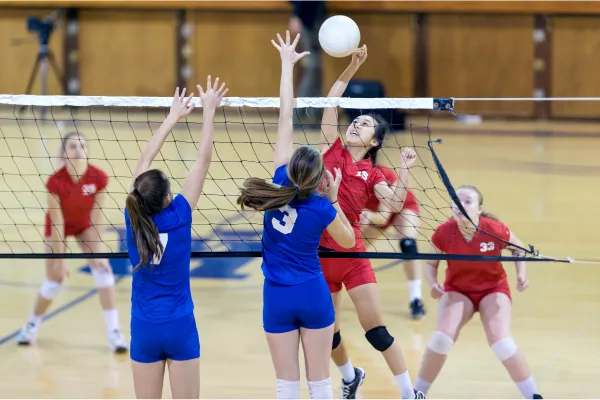
Significance Breakdown
Why invest time in mastering the back row attack? It’s more than points. A successful back row attack disturbs the opponent’s defense, giving a strategic advantage. It forces the opposing team to adapt, potentially opening up opportunities for additional offensive plays.
Tips for Back Row Attack
Training for a successful back row attacks in volleyball requires a combination of skill development, agility, and strategic understanding. Here are essential training tips:
| Sr No | Tip | Description |
|---|---|---|
| 1 | Footwork and Approach | Focus on quick and precise footwork to approach the ball with speed. A well-timed approach sets the foundation for a powerful back row attack. |
| 2 | Timing and Coordination | Develop timing skills to jump when needed. Setter-back-row hitter coordination is essential for smooth execution. |
| 3 | Topspin Jump Serve | Mastering a topspin jump serve enhances overall skills and adds versatility to your game. It helps improve hitting positions and allows for a more effective back row attack. |
| 4 | Study Opponent Formations | Understand the defensive formations of opponents. Identifying gaps in their defense will aid in executing successful back-row attacks. |
| 5 | Varied Attacks | Line, cross-court, and roll back row attacks should be practiced. This variety keeps opponents guessing and boosts your offense. |
| 6 | Wait for the Right Moment | Timing is crucial. Wait for the ball and approach it at full speed, hitting it at just the right moment. |
| 7 | Front-Back Coordination | If your team employs split hitters, ensure coordination between front-row and back-row attackers. Understanding where the front-row hitters are attacking can optimize offensive strategies. |

Strategies Made Simple
Teams use various strategies to make the most of the back row attack. One common approach is to keep the opposing team on their toes by integrating the back row attack into a diverse offensive playbook.
Consequently, this element of surprise can be a game-changer, creating opportunities for other plays.
Is There a Hand Signal For Back Row Attacks?
Yes, hand signals are used in volleyball to indicate a back row attacks. The specific hand signals may vary slightly among teams, but some standard conventions exist. Generally, the setter often initiates these signals to communicate the intention of executing a back row attack.
| Sr No | Hand signal | Description |
|---|---|---|
| 1 | Closed Hand | Back row attacks are often signaled by the closed fist. Many teams use a closed hand to tell the server to deliver the ball to the back-row hitter to assault. Setters often signal the play to other players. |
| 2 | To the back | A simple point to the back of the court is another signal. An attack from the back row is intended when the setter sets the ball with one hand. Players frequently receive this signal from the setter to indicate the next play. |
| 3 | Wave or sweep backward | Some teams wave or sweep backwards to call a back row charge. This move suggests the ball will be passed to a back-row batter to assault. The setter or leader can direct the team with this signal. |
| 4 | Press Back | A light back tap can suggest a sneaky back row attack. Setters use this to secretly communicate with the back row player they wish to hit the ball to. |
| 5 | Nonverbal Eye Contact | When the server and back-row batter glance at each other to signal the play, they communicate without words. This approach is best used when both players know what the other is preparing and keeping the play hidden is crucial. |

Can a Libero Make a Back Row Attack?
Liberos cannot hit from the back row in volleyball. The libero and other back row players cannot jump and attack the ball from anywhere on the floor when it is above the net.
The libero must protect and play in the back row when the ball is above the net. This prevents them from finishing a court-wide attack.
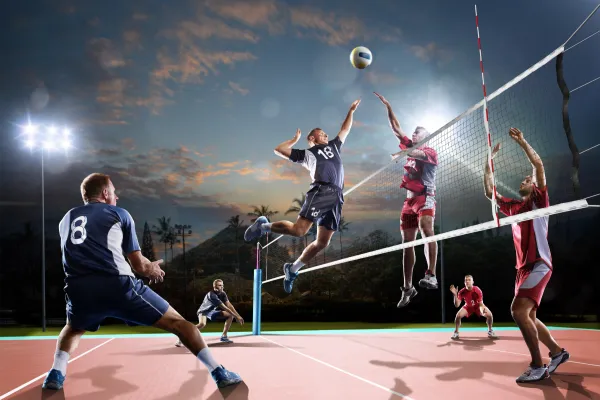
Common Mistakes Unveiled
Even skilled players can slip up. Common mistakes include mistimed jumps, poor approach angles, and giving away intentions too early. However, Identifying and addressing these issues allows players to refine their technique and minimize errors in critical game moments.
Transitions Between Front and Back Row Plays
An attack needs seamless transitions to work. Players must communicate and be aware of their surroundings to keep the offensive flowing.
FAQs
A volleyball back row attacks are not illegal. Fair play and strategic implementation are ensured by rules like the player being behind the attack line and the ball not being above the net.
No, a libero cannot spike the ball in volleyball. Liberos cannot make attack hits, including spikes, to preserve their defensive role on the court.
In volleyball, a player in the back row defines a back row attacks through an offensive play. Positioned in the back row, the player jumps and strikes the ball above the net’s height, executing this attack after receiving a legal set from a teammate.
According to volleyball rules, a back-row setter cannot execute a dump or a setter attacks. The setter must be in the front row to legally dump the ball over the net.
According to volleyball rules, back row players cannot participate in blocking at the net. Front row players exclusively reserve the privilege of blocking.
Conclusion
The volleyball back row attacks are dynamic and strategic, requiring ability, accuracy, and coordination. Understanding the basics, player circumstances, and mechanics is essential to mastering this technique.
Moreover, the back row attack disturbs the other team’s defense, provides you strategic advantages, and helps you make more offensive plays. Back row strikes need speed, strength, and coordination training.
Furthermore, smooth front-row-to-back-row transitions and surprise can change the game. Players should watch out for frequent faults like jumping too early or not approaching the ball to improve.
Additionally, Back row attack rules establish player positions, takeoff points, ball contact restrictions, and more to ensure fairness. Hand signals are vital for communicating back row attack intent.
Liberos are vital to defense, but they can’t hit from behind. The opposite team gets points for breaking the rules, which referees monitor.
Learning the back row assault strengthens a team’s offense, giving them an edge in competitive volleyball. Players can develop and help their team win by following the FIVB rules, training consistently, and playing strategically.
Related Posts
Why Do Volleyball Players Tape Their Fingers & How To Tape
What is a Double Hit in Volleyball?
Can You Use Your Head In Volleyball?

Hassan Baig a former volleyball player, coach and Administrative At Volleyplan.com.
My name is Hassan Baig and I am a former volleyball player and coach. I have a passion for the sport and have dedicated my life to promoting it. I have worked with some of the best players in the game and have helped them achieve their full potential Read More


